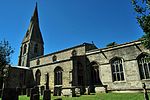Teigh

Teigh is a village and civil parish in the county of Rutland in the East Midlands of England. The population of the village was 48 in the 2001 census. At the 2011 census the population remained less than 100 and was included with the civil parish of Market Overton. It is notable for its Holy Trinity Church, almost unaltered since a 1782 rebuild by Robert Sherard, 4th Earl of Harborough, that features pews that face one another rather than the altar. Both the parish church and the Old Rectory of 1740 are Grade II* listed buildings. The Old Rectory was used for the filming of the 1995 BBC series of Pride and Prejudice; it served as Hunsford parsonage, Mr Collins's modest home. The village's name origin is unsure, the name probably means 'a small enclosure' or 'a meeting place'.The writer Arthur Mee proposed Teigh as one of the few Thankful Villages which lost no men in the First World War.
Excerpt from the Wikipedia article Teigh (License: CC BY-SA 3.0, Authors, Images).Teigh
Pinfold Lane,
Geographical coordinates (GPS) Address Nearby Places Show on map
Geographical coordinates (GPS)
| Latitude | Longitude |
|---|---|
| N 52.737 ° | E -0.663 ° |
Address
RAF Cottesmore Golf Club
Pinfold Lane
LE15 7FG
England, United Kingdom
Open on Google Maps







